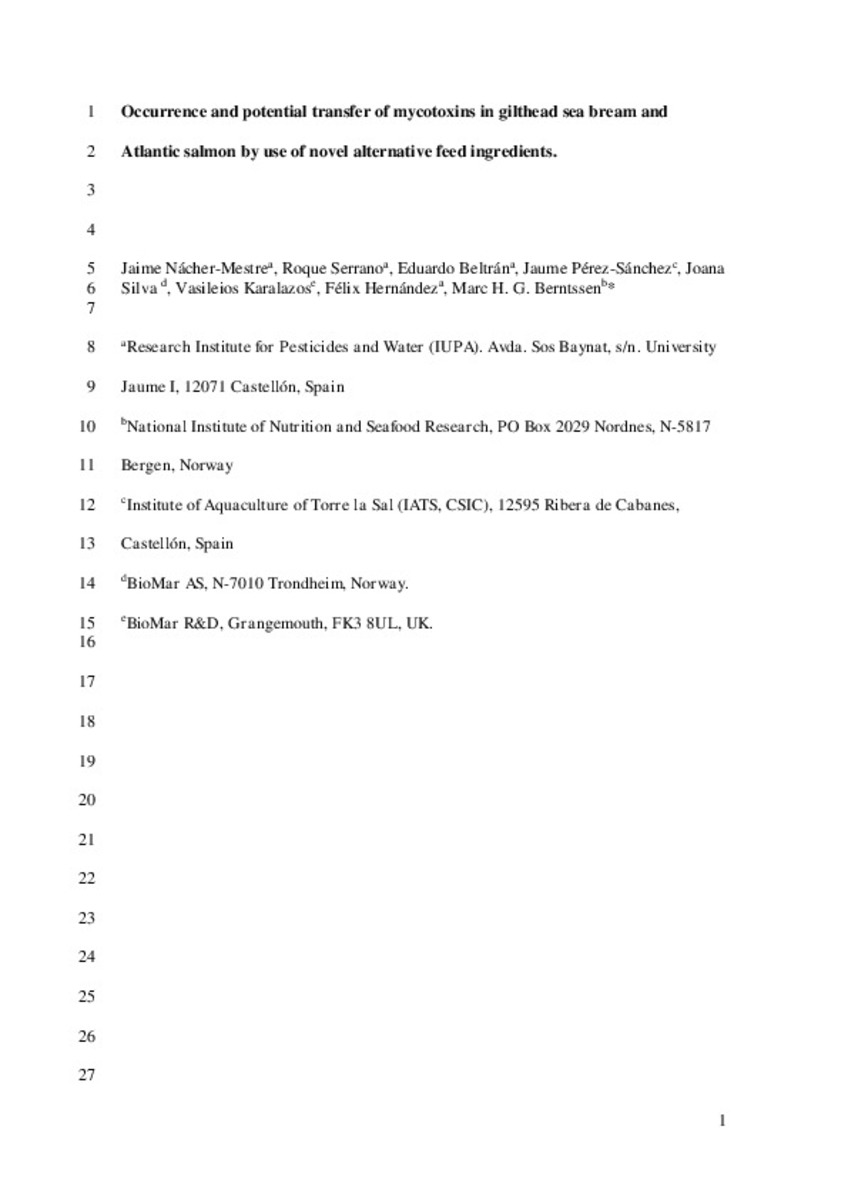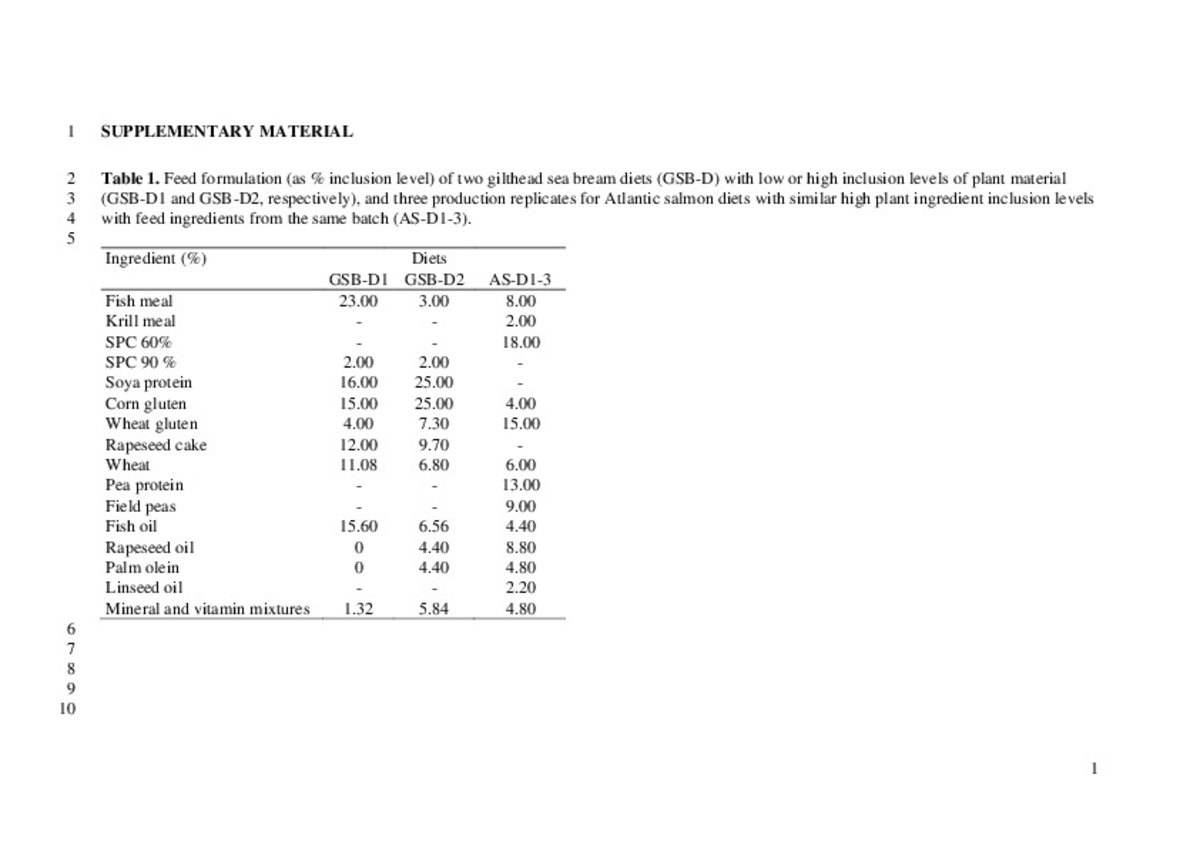Mostrar el registro sencillo del ítem
Occurrence and potential transfer of mycotoxins in gilthead sea bream and Atlantic salmon by use of novel alternative feed ingredients
| dc.contributor.author | Nácher Mestre, Jaime | |
| dc.contributor.author | Serrano, Roque | |
| dc.contributor.author | Beltrán Iturat, Eduardo | |
| dc.contributor.author | Pérez Sánchez, Jaume | |
| dc.contributor.author | Silva, Joana | |
| dc.contributor.author | Karalazos, Vasileios | |
| dc.contributor.author | Hernandez, Felix | |
| dc.contributor.author | Berntssen, Marc H. G. | |
| dc.date.accessioned | 2016-01-26T09:01:14Z | |
| dc.date.available | 2016-01-26T09:01:14Z | |
| dc.date.issued | 2015 | |
| dc.identifier.issn | 0045-6535 | |
| dc.identifier.issn | 1879-1298 | |
| dc.identifier.uri | http://hdl.handle.net/10234/146826 | |
| dc.description.abstract | Plant ingredients and processed animal proteins (PAP) are suitable alternative feedstuffs for fish feeds in aquaculture practice, although their use can introduce contaminants that are not previously associated with marine salmon and gilthead sea bream farming. Mycotoxins are well known natural contaminants in plant feed material, although they also could be present on PAPs after fungi growth during storage. The present study surveyed commercially available plant ingredients (19) and PAP (19) for a wide range of mycotoxins (18) according to the EU regulations. PAP showed only minor levels of ochratoxin A and fumonisin B1 and the mycotoxin carry-over from feeds to fillets of farmed Atlantic salmon and gilthead sea bream (two main species of European aquaculture) was performed with plant ingredient based diets. Deoxynivalenol was the most prevalent mycotoxin in wheat, wheat gluten and corn gluten cereals with levels ranging from 17 to 814 and μg kg−1, followed by fumonisins in corn products (range 11.1–4901 μg kg−1 for fumonisin B1 + B2 + B3). Overall mycotoxin levels in fish feeds reflected the feed ingredient composition and the level of contaminant in each feed ingredient. In all cases the studied ingredients and feeds showed levels of mycotoxins below maximum residue limits established by the Commission Recommendation 2006/576/EC. Following these guidelines no mycotoxin carry-over was found from feeds to edible fillets of salmonids and a typically marine fish, such as gilthead sea bream. As far we know, this is the first report of mycotoxin surveillance in farmed fish species. | ca_CA |
| dc.description.sponsorShip | EU Seventh Framework Programme by ARRAINA Project, 288925. project SAFE-PAP, Research Council Research and Development Project National Institute of Nutrition and Seafood Research (NIFES, Norway), 227387. Generalitat Valenciana, PROMETEO II/2014/023 PROMETEO II/2014/085 ISIC/2012/016 | ca_CA |
| dc.format.extent | 27 p. | ca_CA |
| dc.format.mimetype | application/pdf | ca_CA |
| dc.language.iso | eng | ca_CA |
| dc.publisher | Elsevier | ca_CA |
| dc.relation.isPartOf | Chemosphere Volume 128, June 2015, Pages 314–320 | ca_CA |
| dc.rights | © 2015 Elsevier Ltd. All rights reserved. | ca_CA |
| dc.rights.uri | http://rightsstatements.org/vocab/InC/1.0/ | * |
| dc.subject | Mycotoxins | ca_CA |
| dc.subject | Marine aquaculture | ca_CA |
| dc.subject | Plant ingredients | ca_CA |
| dc.subject | Processed animal proteins | ca_CA |
| dc.subject | Fish feed | ca_CA |
| dc.subject | Fish | ca_CA |
| dc.title | Occurrence and potential transfer of mycotoxins in gilthead sea bream and Atlantic salmon by use of novel alternative feed ingredients | ca_CA |
| dc.type | info:eu-repo/semantics/article | ca_CA |
| dc.identifier.doi | http://dx.doi.org/10.1016/j.chemosphere.2015.02.021 | |
| dc.rights.accessRights | info:eu-repo/semantics/openAccess | ca_CA |
| dc.relation.publisherVersion | http://www.sciencedirect.com/science/article/pii/S004565351500123X | ca_CA |
| dc.type.version | info:eu-repo/semantics/acceptedVersion |
Ficheros en el ítem
Este ítem aparece en la(s) siguiente(s) colección(ones)
-
IUPA_Articles [306]








